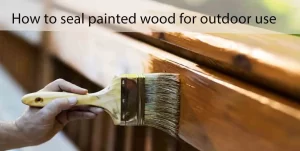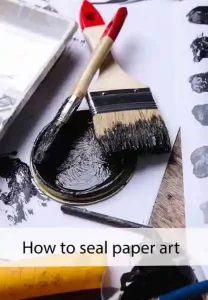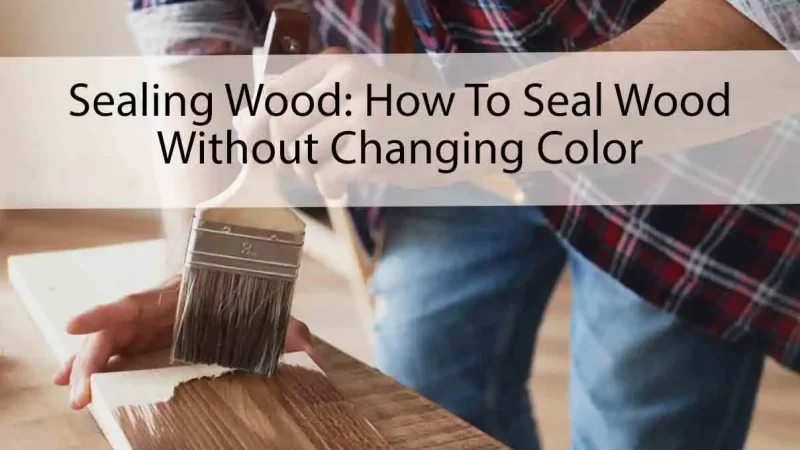The color of the wood is one of the most important factors that contribute to its beauty. Sealing wood can help protect it from damage, but it can also change the color of the wood.
Sealing wood is a process of protecting it from the elements and preventing it from warping, rotting, or splitting. You can use various products to seal the wood, including oil-based sealers, water-based sealers, and varnishes. Wood sealers are available in clear and tinted versions.
Before you seal the wood, it is important to understand how sealing will affect the color of the wood.
What is a wood sealer?

It can also help prevent the wood from fading or discoloring over time. There are various types of wood sealers available on the market, and each one has its own set of benefits and drawbacks. Choosing the right sealer for your project will depend on several factors, including the type of wood you are working with, the finish you want to achieve, and the level of protection you need.
Sealing Wood Does Not Always Change the Color:
Many people believe that sealing wood will always change the color of the wood. However, this is not always the case. Sealing wood does not always change the color of the wood. In fact, it is possible to seal wood without changing the color.
It would be best to keep in mind a few things when sealing the wood. The type of wood, the type of sealer, and the method of application will all play a role in the final color of the wood.
Types of Wood
The type of wood is one of the most important factors that will determine the final color of the wood. Some woods are more porous than others and will absorb more sealer. This can result in a darker color.
The type of wood that you use will also affect the final color of the wood. Other woods are less porous and will not absorb as much sealer. This can result in a lighter color.
Types of Sealers
The type of sealer that you use will also affect the final color of the wood. Oil-based sealers can darken the wood, while water-based sealers can lighten the wood.
Tinted sealers can also change the color of the wood. The amount of tint added to the sealer will determine the final color of the wood. Sealers intended for outdoor use will typically have a higher level of tint to protect the wood from the sun.
Clear sealers will not change the color of the wood. So, if you want to seal the wood without changing the color, you should use a clear sealer.
The Method of Application
The method of application will also affect the final color of the wood. If you apply the sealer with a brush, it is more likely to change the color of the wood.
If you apply the sealer with a rag, it is less likely to change the color of the wood. Some people prefer to apply the sealer with a sprayer. This can help prevent the sealer from changing the color of the wood.
Avoiding Color Change When Sealing Wood:
There are a few things that you can do to avoid changing the color of the wood when you seal it.
First, you should always test the sealer on a small area of the wood before applying it to the entire piece. This will give you an idea of how the sealer will affect the color of the wood.
Second, you should use a clear sealer if you do not want the color of the wood to change.
Third, you should apply the sealer with a rag or a sprayer. This will help prevent the sealer from changing the color of the wood.
Fourth, you should seal the wood in a well-ventilated area. This will help prevent the sealer from changing the color of the wood.
Fifth, you should allow the sealer to dry completely before applying a second coat. This will help prevent the sealer from changing the color of the wood.
Sealing wood is a process of protecting it from the elements and preventing it from warping, rotting, or splitting.
How to waterproof wood before painting?

When selecting a sealer, it is important to choose one compatible with the type of wood you are sealing. For example, if you are sealing a hardwood, you will want to use a sealer designed for hardwoods. If you are sealing softwood, you will want to use a sealer designed for softwoods.
Once you have selected the appropriate sealer, you will need to apply it to the wood. You can apply sealers with a brush, a roller, or a sprayer. If you are using a brush, use a synthetic brush, as natural bristles will absorb the sealer and make it difficult to apply evenly.
Once the sealer has been applied, you will need to allow it to dry. Depending on the type of sealer you are using, this could take a few hours to a few days. Once the sealer is dry, you can apply paint or stain if desired.
How to seal painted wood for outdoor use?

Mix 1 part boiled linseed oil with 2 parts turpentine to make your sealer. Apply the mixture to the painted wood with a clean cloth and let it dry for 24 hours. You can apply a second coat if you like, but it isn’t necessary. This sealer will help protect the paint from the elements and keep it looking its best.
If you want to keep the natural color of your wood, you can use a clear sealer. This will protect the wood from the elements and help keep it looking its best. If you’re using a sealer for the first time, it’s good to test it on a small area of the wood to make sure it doesn’t change the color.
Once you’ve sealed the wood, you can enjoy it for years to come. This simple step will help keep your furniture looking its best even after years of use.
How to seal acrylic paint on wood for outdoors?
Acrylic paint is a great choice for painting outdoors because it doesn’t require a primer, and it’s less likely to fade in sunlight.
However, if you want to protect your paint job from the elements, you’ll need to seal it with a clear coat. You can buy a clear acrylic sealer at any hardware store or use a polyurethane sealer. Either way, apply the sealer with a brush or a roller and allow it to dry completely before painting over it.
If you’re planning to paint furniture or another object that will be exposed to the elements, you may want to seal the wood first. This will help protect the wood from moisture and rot.
You can buy a waterproofing sealer at any hardware store, or you can make your own by mixing one part linseed oil with two parts turpentine. Apply the mixture to the wood with a brush and allow it to soak in for several hours before painting.
The paint will be less likely to peel off or fade over time.
How long does wood sealer take to dry?
Wood sealers can take anywhere from 2 to 4 hours to dry. But, before you can determine how long your wood sealer will take to dry, you need to know the type of finish.
Water-based finishes are usually dry to the touch within an hour and will be ready for a second coat in about 4 hours. Oil-based finishes will take a little longer to dry to the touch, usually 2 to 3 hours. But they will be ready for a second coat in about 8 hours.
You can speed up the drying time of your wood sealer by using a hairdryer or fan. Just be sure not to point the hairdryer or fan directly at the wood sealer, as this can cause bubbles to form in the finish.
You can typically apply a third coat of sealer after the second coat has dried for 24 hours. However, you should always check the manufacturer’s instructions to be sure.
How to seal paper art?

To use a clear acrylic sealer, brush it onto your paper art. You can apply multiple coats if you want to, but let each coat dry before applying the next.
To use a Mod Podge sealer, you must first mix the Mod Podge with water in a 1:1 ratio. Once it is mixed, brush it onto your paper art. As with the acrylic sealer, you can apply multiple coats.
Hold the can about 6 inches away from your paper art and spray it evenly to use spray varnish. Be sure to apply multiple thin coats rather than one thick coat.
Whichever method you choose, let the sealer dry completely before framing or displaying your paper art.
How long does ready seal take to dry?
Ready Seal is a wood sealant that does not change the color of the wood. It is available in clear and tinted formulas. The clear formula will take longer to dry than the tinted formula. Depending on the temperature and humidity, it can take anywhere from 2 to 8 hours for the sealant to dry completely.
However, it is recommended that you wait 24 hours before applying a second coat or before using the sealed surface. Some people choose to wait even longer, up to a week, to ensure the sealant is completely dry and cured. In general, the warmer and drier the weather, the faster the sealant will dry.
Conclusion:
Sealing wood is necessary to protect it from the elements and ensure its longevity. However, many people are hesitant to do so because they fear that the sealing process will change the wood’s color.
Fortunately, there are now many clear sealants on the market that will not alter the color of your wood. Follow the instructions on the sealant packaging to ensure the best results, and enjoy your beautiful, protected wood for years to come!


6 thoughts on “Wood Sealer: How To Seal Wood Without Changing Color?”
Comments are closed.